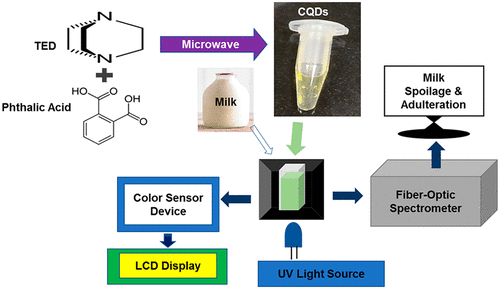当前位置:
X-MOL 学术
›
ACS Food Sci. Technol.
›
论文详情
Our official English website, www.x-mol.net, welcomes your
feedback! (Note: you will need to create a separate account there.)
Translation of Carbon Dot Biosensors into an Embedded Optical Setup for Spoilage and Adulteration Detection
ACS Food Science & Technology ( IF 2.6 ) Pub Date : 2021-06-09 , DOI: 10.1021/acsfoodscitech.1c00089 Sandeep Choudhary 1 , Bhavana Joshi 1 , Abhijeet Joshi 1
ACS Food Science & Technology ( IF 2.6 ) Pub Date : 2021-06-09 , DOI: 10.1021/acsfoodscitech.1c00089 Sandeep Choudhary 1 , Bhavana Joshi 1 , Abhijeet Joshi 1
Affiliation

|
This research demonstrates a carbon quantum dot (CQD) based fluorescence technique for milk quality assessment and detection of urea adulteration using a commercialized optical fiber spectrometer (OFS) and a developed color sensor device (CSD). The change in pH from the normal pH of milk (∼6.7) indicates spoilage. The CQDs were synthesized using phthalic acid (carbon source) and triethylenediamine (TED) (passivant). The CQDs were found to be sensitive in the pH range 3–10 with a quantum yield of about 18.9%. The accuracy of spoilage detection using CQDs was expressed in the form of mean percent recovery and found to be 99.2% (R2 = 0.97) by the OFS and 99.59% (R2 = 0.98) by the CSD. The mean percent recovery obtained for urea adulteration in milk was 103.0% (R2 = 0.98) by the OFS and 97.9% (R2 = 0.97) by the CSD. The results indicate that CQDs have excellent potential for use as biosensors for spoilage and adulteration detection.
中文翻译:

将碳点生物传感器转化为用于腐败和掺假检测的嵌入式光学装置
本研究展示了一种基于碳量子点 (CQD) 的荧光技术,该技术使用商业化的光纤光谱仪 (OFS) 和开发的颜色传感器设备 (CSD),用于牛奶质量评估和尿素掺假检测。牛奶的正常 pH 值 (~6.7) 的 pH 值变化表明变质了。CQDs 使用邻苯二甲酸(碳源)和三亚乙基二胺(TED)(钝化剂)合成。发现 CQD 在 3-10 的 pH 范围内敏感,量子产率约为 18.9%。使用 CQD 检测腐败的准确性以平均百分比回收率的形式表示,OFS发现其为 99.2% ( R 2 = 0.97),CSD发现其为99.59% ( R 2 = 0.98)。牛奶中掺假尿素的平均回收率为 103.0% (OFS 的R 2 = 0.98) 和CSD 的97.9% (R 2 = 0.97)。结果表明,CQD 具有用作检测腐败和掺假的生物传感器的巨大潜力。
更新日期:2021-07-16
中文翻译:

将碳点生物传感器转化为用于腐败和掺假检测的嵌入式光学装置
本研究展示了一种基于碳量子点 (CQD) 的荧光技术,该技术使用商业化的光纤光谱仪 (OFS) 和开发的颜色传感器设备 (CSD),用于牛奶质量评估和尿素掺假检测。牛奶的正常 pH 值 (~6.7) 的 pH 值变化表明变质了。CQDs 使用邻苯二甲酸(碳源)和三亚乙基二胺(TED)(钝化剂)合成。发现 CQD 在 3-10 的 pH 范围内敏感,量子产率约为 18.9%。使用 CQD 检测腐败的准确性以平均百分比回收率的形式表示,OFS发现其为 99.2% ( R 2 = 0.97),CSD发现其为99.59% ( R 2 = 0.98)。牛奶中掺假尿素的平均回收率为 103.0% (OFS 的R 2 = 0.98) 和CSD 的97.9% (R 2 = 0.97)。结果表明,CQD 具有用作检测腐败和掺假的生物传感器的巨大潜力。











































 京公网安备 11010802027423号
京公网安备 11010802027423号